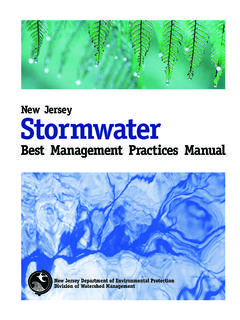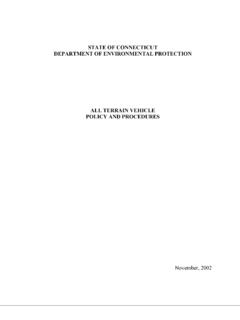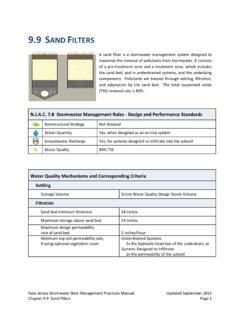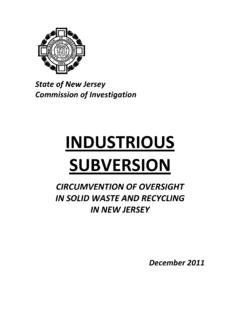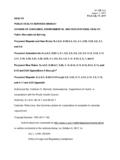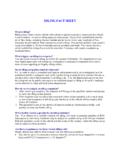Transcription of Hydrogeologic Testing and Reporting Procedures …
1 NEW jersey GEOLOGICAL &. WATER SURVEY. Technical Memorandum 12-2. Hydrogeologic Testing and Reporting Procedures in Support of New jersey Water Allocation Permit Applications New jersey department of environmental protection STATE OF NEW jersey . Chris Christie, Governor Kim Guadagno, Lieutenant Governor department of environmental protection Bob Martin, Commissioner Water Resources Management Michele Siekerka, Assistant Commissioner Division of Water Supply and Geosciences Fred Sickels, Director New jersey Geological and Water Survey Karl Muessig, State Geologist NEW jersey department OF environmental protection . NJDEP's core mission is and will continue to be the protection of the air, waters, land and natural and his- toric resources of the State to ensure continued public benefit.
2 The department 's mission is advanced through effective and balanced implementation and enforcement of environmental laws to protect these resources and the health and safety of our residents. At the same time, it is crucial to understand how actions of this agency can impact the State's economic growth, to recognize the interconnection of the health of New jersey 's environment and its economy, and to appreciate that environmental stewardship and positive economic growth are not mutually exclusive goals: we will continue to protect the environment while playing a key role in positively impacting the eco- nomic growth of the state.
3 NEW jersey GEOLOGICAL and WATER SURVEY. The mission of the New jersey Geological and Water Survey is to map, research, interpret and provide sci- entific information regarding the state's geology and groundwater resources. This information supports the regulatory and planning functions of DEP and other governmental agencies and provides the business community and public with information necessary to address environmental concerns and make economic decisions. +++++++++++++. for more information contact New jersey department of environmental protection New jersey Geological and Water Survey Division of Water Supply and Geoscience Box 420, Mail Code 29-01 Box 420, Mail Code: 401-03.
4 Trenton, NJ 08625-0420 Trenton, NJ 09625-0420. (609) 984-6587 (609) 292-7219. On the cover: Schematic diagrams of wells drawing water from unconsolidated and bedrock aquifers. Modified from Heath, 1983, p. 52. ii NEW jersey GEOLOGICAL AND WATER SURVEY. Technical Memorandum 12-2. Hydrogeologic Testing and Reporting Procedures in Support of New jersey Water Allocation Permit Applications by Jeffrey L. Hoffman, Ovidiu Petriman, Mike Bleicher, Jim Boyle, Steve Domber, Mark French, Jan Gheen, Steve Johnson, Bill Mennel, Jennifer Myers, Laura Nicholson, Helen Rancan, Eric Roman and Richard Shim-Chim New jersey department of environmental protection Water Resources Management Division of Water Supply and Geoscience New jersey Geological and Water Survey PO Box 420, Mail Stop 29-01.
5 Trenton, NJ 08625. 2012. iii Conversion Factors Multiply to obtain Multiply to obtain by by inch-pound units metric (SI) units inch-pound units metric (SI) units VOLUME FLOW RATE. 3 3. cubic inches (in ) cubic centimeters (cm ) million gallons/day (mgd) cubic meters/second (m3/s). cubic feet (ft3) cubic meters (m3) cubic feet per second (cfs) 2,447. Cubic meters/day (m3/d). 3. gallons (gal) liters (L) million gallons/year (mgy) 3,785. Cubic meters/year(m /y). gallons (gal) cubic meters (m3) gallons/minute (gpm) .06309 liters/second (L/s). Note: In this report 1 billion = 1,000 million; 1 trillion = 1,000 billion New jersey Geological and Water Survey Reports (ISSN 0741-7357) are published by the New jersey Geologi- cal and Water Survey, PO Box 420, Trenton, NJ 08625-0420.
6 This report may be reproduced in whole or part provided that suitable reference to the source of the copied material is provided. More information on NJGWS reports is available on the Survey's website: Note: Any use of trade, product, or firm names in this publication is for descriptive purposes only and does not imply endorsement by the New jersey state government. "No one shall draw water without an authorization from Caesar, that is, no one shall draw water from the public supply without a license, and no one shall draw more than has been granted.". - Sextus Julius Frontinus, The Aqueducts of Rome (ca 100 CE). Frontinus lived between approximately 35.
7 And 103 CE. He was appointed water commissioner for Rome by Nerva Augustus about 97 CE. He was governor of Britain from 75-97 CE. (Evans, 1997). iv Contents I. Abstract ..1. II. Introduction ..3. A. Purpose ..3. B. Authority ..5. C. Potential impacts ..8. 1. groundwater users ..9. 2. groundwater contamination ..9. 3. saltwater intrusion ..10. 4. streams ..10. 5. lakes and ponds ..11. 6. sustainable water-resource yield ..11. 7. wetlands ..12. D. Overview ..13. 1. background geologic and hydrologic information ..13. 2. pre-application meeting ..14. 3. aquifer-test 4. approval of the aquifer-test proposal ..15. 5. notification.
8 15. 6. Hydrogeologic tests ..15. 7. analysis and interpretation of data ..16. 8. final Hydrogeologic E. Previous editions ..17. F. Currency ..17. G. Acknowledgements ..17. III. Other Requirements and Restrictions ..19. A. Permitting requirements ..19. 1. well permits ..19. 2. permit-by-rule ..20. 3. other Division of Water Supply and Geoscience permits ..20. 4. other permits ..20. B. Restrictions ..21. 1. water supply critical areas ..21. 2. water supply reservoirs ..22. 3. areas of limited water availability ..22. C. Other relevant agencies ..22. 1. Pinelands ..22. 2. Highlands ..23. v 3. Delaware River Basin Commission.
9 23. D. Notification ..24. 1. aquifer-test proposal and reviews ..24. 2. local health department and well owners ..24. 3. Public notice and hearing on the application ..24. IV. Information Tools ..25. A. Existing well B. Water allocation availability screening tool ..25. C. Interactive mapping ..25. D. Data miner ..26. E. New jersey Geological and Water Survey ..26. F. United States Geological Survey ..26. V. Aquifer-Test Proposal ..29. A. Justification ..29. B. Description ..29. C. Estimated drawdown pattern ..30. D. Changes after E. Waiver request ..31. VI. Types of Aquifer Tests ..33. A. Step tests ..33. 1. select the pumping rate for each step.
10 34. 2. run the step test ..34. 3. collect test data ..34. 4. calculate the efficiency of the well ..35. 5. determine the stable yield ..35. B. Single-pumping-well drawdown test ..35. 1. purpose ..35. 2. duration ..36. 3. aquifer properties ..36. 4. hydrologic impacts ..37. C. Multiple-pumping-well drawdown test ..38. VII. Single-Pumping Well and Multiple-Pumping-Well Test-Design Factors ..39. A. Nearby pumpage ..39. B. Observation wells ..40. C. Test periods ..41. 1. background ..42. 2. pumping ..42. 3. recovery ..43. D. Pumping rate ..43. E. Sustaining and measuring the pumping rate ..44. F. Discharge of pumped water.
